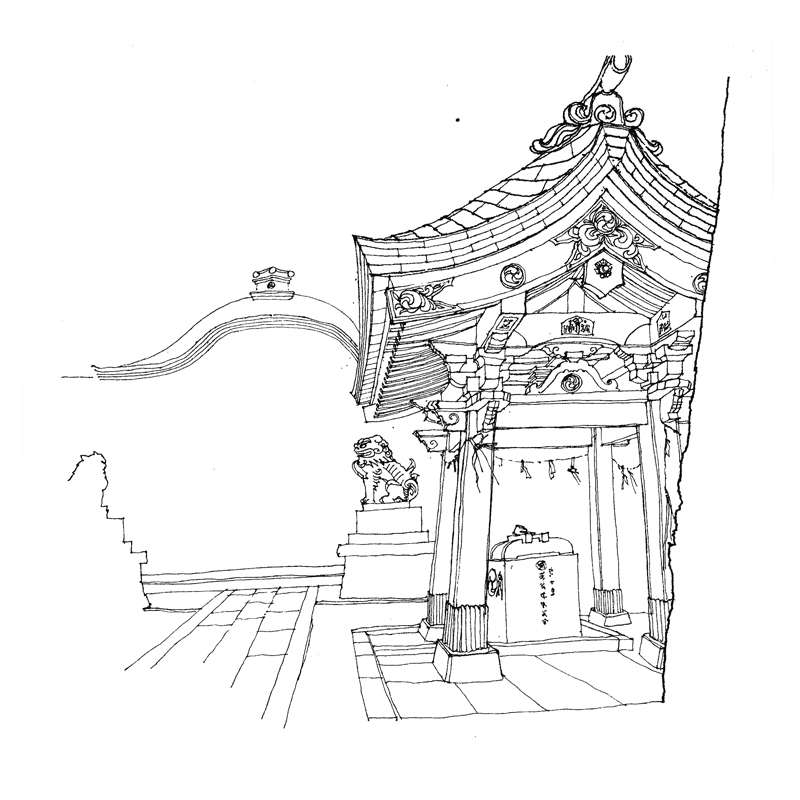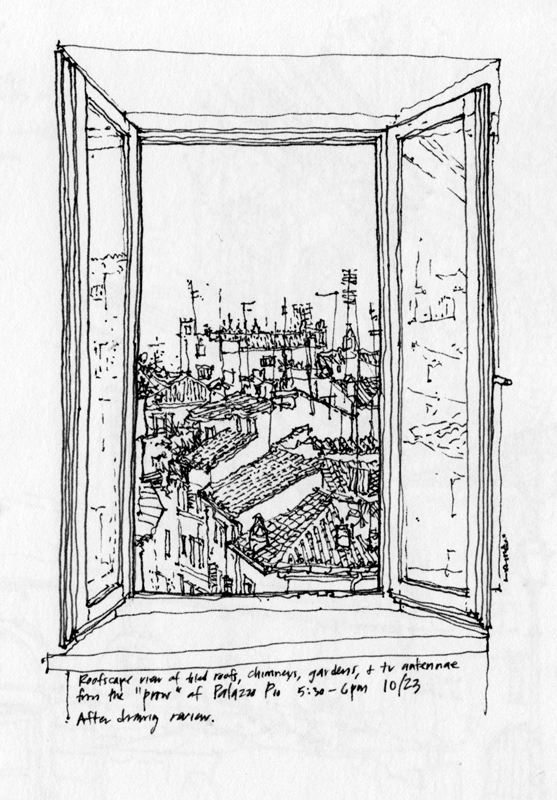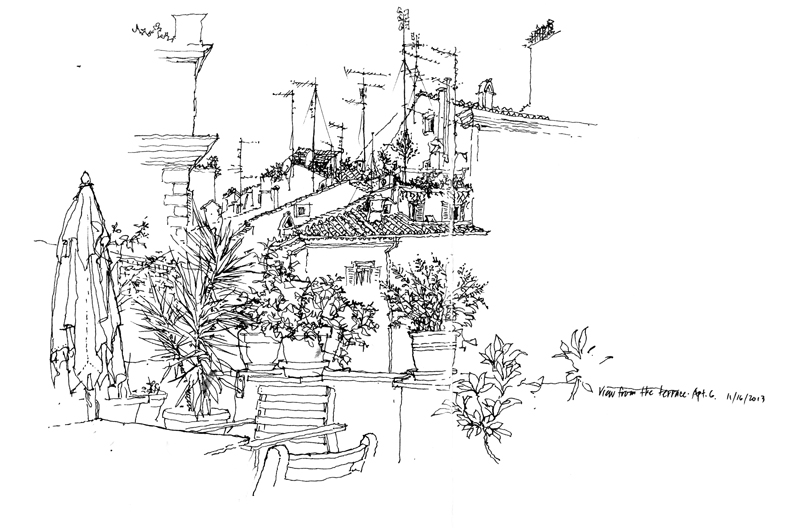 The heart of sumi-e style paintings is their negative spaces, which viewers can fill in according to their imagination. Here are a few sketches attempting to make use of the same principle.
The heart of sumi-e style paintings is their negative spaces, which viewers can fill in according to their imagination. Here are a few sketches attempting to make use of the same principle.

Notebooks, sketchbooks, journals… whatever one chooses to call these bound collections of pages, they all provide a physical sense of permanence and chronology and, in use, they become a repository of images and writings capable of reminding us of where we have been, what we have seen, and what we have experienced. But even as we acknowledge the pleasure of perusing these collections, we should also appreciate the process by which they are made. No single page in a journal is precious; not all pages must be perfect. In the act of making visible our experiences, reflections, and discoveries, we become more sensitive to and connected with our surroundings, expand our visual memories, and stimulate our imagination.
Happened to watch an episode of the new NBC game show, The Wall, which reminded me of this pachinko parlor in Tokyo. The Wall features an oversized version of the pachinko board, which operates like a vertical pinball machine. In pachinko, one or more steel balls are launched to the top of the playing field, which is filled with brass pins. Entering the field at the top, the steel balls fall freely, bouncing and careening from one pin to another, and finally entering one of several cups at the bottom. Upon entering a pachinko parlor, one is greeted with the chime-like sounds of the falling steel balls from hundreds of pachinko machines.
While the recent cold snap is easing a bit here in Seattle with temperatures returning to the upper 30s, I still miss the warmth and fragrance of Hawaii. During our recent trip there, I did this quick 20-minute sketch while waiting for the weekly Friday performance by the Royal Hawaiian Band on the grounds of Iolani Palace. King Kamehameha III founded the brass band in 1836, which is now considered to be the oldest, full-time municipal band in the U.S. I still remember as a child growing up in Honolulu attending their Sunday afternoon concerts at the Kapiolani Park Bandstand in Waikiki.
When Joseph Fern became mayor of the City & County of Honolulu in 1907, he began a campaign to build a permanent city hall. Unfortunately, it was not until 1928, eight years after Fern’s death, that the idea came to fruition. Several local architects—C.W. Dickey, Hart Wood, Robert Miller, and Rothwell Kangeter & Lester—contributed to the design of the Spanish Colonial Revival style structure, which has an interior courtyard, staircase, and open ceiling modeled after the Bargello in Florence.
Originally called the Honolulu Municipal Building, today it is known as Honolulu Hale (Honolulu House) and is the official seat of government of the city and county, including the Mayor’s office and the City Council chambers. In 1978, Honolulu Hale was listed as a contributing property to the Hawaii Capital Historic District, which is listed on the National Register of Historic Places and includes Iolani Palace, Kawaiahaʻo Church, and the Territorial Building.
This is a view of a courtyard in the Rainbow Bazaar in the Hilton Hawaiian Village Hotel in Waikiki, dominated by a huge banyan tree. The resort hotel was originally conceived of and built by Fritz Burns and industrialist Henry Kaiser in 1955 on the site of the old Niumalu Hotel and eight oceanfront acres of the Ena Estate at the Ewa end of Waikiki. Over time, the hotel complex grew to 22 acres and was purchased by Conrad Hilton.
Growing up in Hawaii, my exposure to the world beyond Oahu’s shores was illuminated through books, movies, and TV shows. And so when the Rainbow Bazaar was created as part of the hotel complex in 1970, I was fascinated by the faux Asian environment, which included replicas of a Thai temple and a Japanese pagoda, as well as an entire Japanese farmhouse shipped from Japan. While some may criticize the appropriation of Asian culture to sell ethnic and tourist goods, for me walking through the Rainbow Bazaar even today is an opportunity to imagine and re-imagine visiting foreign places.

 After a month of record rainfall and predictions of more rain to come, it’s becoming increasingly difficult to find areas sheltered enough from the weather to draw comfortably outdoors. So here I want to remind myself of the wonderful times I was privileged to spend in Rome where the fall weather was always sunny and warm.
After a month of record rainfall and predictions of more rain to come, it’s becoming increasingly difficult to find areas sheltered enough from the weather to draw comfortably outdoors. So here I want to remind myself of the wonderful times I was privileged to spend in Rome where the fall weather was always sunny and warm.
These two views are from the Palazzo Pio in Rome, which overlooks the Campo dei Fiori. If we bothered to look up rather than at the many historic structures and monuments one runs into in the Centro Historico, we would see that the rooftops are often filled with terraces, potted plants, tiny apartments, and, of course, the forest of TV antennas that are gradually giving way to satellite dishes.
Here are two scenes I sketched our last day in Querétaro. The first is of the Plaza de Armas, also known as the Plaza de Independencia. Around its periphery are 18th-century mansions and outdoor cafes. To the right is Palacio de la Corregidora, former home of the city’s mayor Don Miguel Dominguez and his wife Josefa Ortiz de Dominguez, who is revered as a heroine of the Mexican War of Independence. Today, the palace serves as the seat of the executive branch of the state government.
The second view is where Calle Venustiano Carranza splits off of Calle 5 de Mayo, another bifurcated view similar to the ones I drew in Tacoma a few weeks ago.
Just returned from spending a few wonderful days in Santiago de Querétaro, a colonial town founded in 1561 by Franciscan priests in the high desert country north of Mexico City. There I led a group of students from the Tecnológico de Monterrey on a drawing tour of the Centro Historico, a UNESCO World Heritage site. Below the group photo taken in a courtyard of the Convento de la Santa Cruz are a few of the quick sketches I did to demonstrate how to compose the perspective structure of the scenes the students were drawing. Many thanks to Professor Paola Gamez Pouzou for her gracious and generous assistance during the two days of workshops.
To conclude my posting of sketches that I did during the 4th Annual West Coast Urban Sketchers Sketch Crawl in Tacoma, here are a couple more from Sunday morning’s session. The temperature drop from the heat of the previous two days was invigorating. What attracted me to these two views was the way the paths bifurcated (split into two branches or forks). The first is where Prairie Line Trail splits off from Pacific Avenue in front of the Tacoma Art Museum. The second is further up along the Prairie Line Trail on the UW Tacoma campus where it merges with Dolly Roberson Lane.